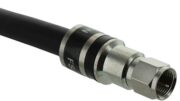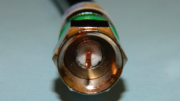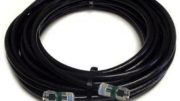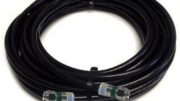I was asked this question by a customer the other day. Just the question scares me. This is a situation where you really need to dive in and understand the dangers. Throughout the article, I’ll be putting important facts in blue insets.
How coaxial cable is different from power cable

This is an image from Wikipedia that shows a typical coaxial cable. There isn’t a whole lot special about this cable or this picture, but it does a good job of showing what most coax cables are like inside.
Center conductor
The cable marked D is the center conductor. It’s where the signal flows. In less expensive cables, the center conductor is made of steel with copper plating. In more expensive cables, it’s solid copper. If you’re putting power through a cable, the center conductor acts as the hot leg. Solid copper cables can carry more current than steel ones, because copper is better at carrying electricity.
IMPORTANT TIP:
Putting current through a steel cable will cause your equipment to stop working. The electricity will get lost over even short distances. The cable will heat up, too. That’s bad.
Dielectric
The part marked C is the dielectric. In less expensive cables it’s plastic, while in more expensive cables it’s foam. It’s essentially an open space where the signal that travels on the center conductor can expand. The signal acts like it’s going through a much thicker cable.
IMPORTANT TIP:
Too much current through a cable can cause the dielectric to heat up or melt. This can cause short circuits and fires.
Braid
The part marked B is the braid. It’s not actually intended to carry signal. In a coaxial cable it shields the dielectric from outside signals. If you are putting power through the cable, it acts as the neutral leg.
IMPORTANT TIP:
The braid is the most delicate part of the cable. It can’t carry much current at all. If too much current passes through the braid it can heat up or melt. This is very bad.
So how much current?
I haven’t tested a cable to see how much current it can take. I like our test labs and I don’t want them to burn down. I will say that the most current I’ve routinely put through a cable is 48 watts. That’s enough to power a bright LED light bulb.
If your device comes with a power inserter or power injector, you can assume it’s safe to use with solid copper cables.
You should NEVER try to put current through a cable without using a power inserter. NEVER connect a cable to an outlet directly. NEVER wire a plug straight to a cable.
The answer is: don’t ask the question
If you’re asking how much current you can put through a coaxial cable, it’s because you’re thinking of using that cable in a way it wasn’t intended. This means you’re running the risk of catching your house on fire. Just don’t do it. Simple as that. Don’t do it.
If you need to send power from place to place, use a high-quality extension cord. That’s the right way to do it.





